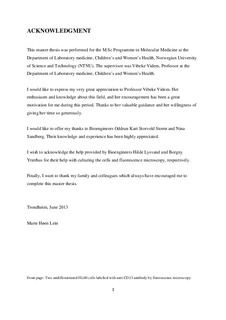| dc.contributor.advisor | Videm, Vibeke | nb_NO |
| dc.contributor.author | Lein, Marte Høen | nb_NO |
| dc.date.accessioned | 2014-12-19T14:19:50Z | |
| dc.date.available | 2014-12-19T14:19:50Z | |
| dc.date.created | 2013-08-27 | nb_NO |
| dc.date.issued | 2013 | nb_NO |
| dc.identifier | 643351 | nb_NO |
| dc.identifier.uri | http://hdl.handle.net/11250/263909 | |
| dc.description.abstract | Background and aim: Neutrophil granulocytes express well known adhesion molecules on their cell membranes that during inflammation participate in neutrophil adhesion to endothelial cells. Earlier experiments have shown that neutrophils adhere to artificial surfaces and biomaterials when known adhesion molecules are inactive, indicating that also other adhesion molecules are involved. Certain proteoglycans expressed on neutrophils are thought to participate in neutrophil adhesion. Neutrophils are short lived cells and cannot be cultured for experimental use. A promyelocytic HL60 cell line can differentiate towards neutrophils and be used as a model to study neutrophil adhesion. The aim of this study was to investigate the expression of certain proteoglycans on HL60 cells and their ability to adhere to artificial surfaces compared to isolated neutrophils.
Methods: HL60 cells were differentiated towards mature neutrophils with stimulation of all-transretinoic-acid. Differentiated HL60 cells were labelled with antibodies against two different proteoglycans, syndecan-4 and CD44, and measured by flow cytometry. Adhesion experiments were performed on differentiated HL60 cells pre-treated with anti-CD44 antibodies and quantified with an enzymatic method based on the level of myeloperoxidase in the cells. Neutrophils were isolated from whole blood from blood donor samples and compared to HL60 cells in the adhesion experiments.
Conclusions: The experiments from flow cytometry showed that differentiated HL60 cells express CD44 on their cell membrane, but there was no expression of syndecan-4 on differentiated HL60. Using antibody-mediated blockage of CD44, adhesion of differentiated HL60 cells and isolated neutrophils to a polystyrene surface was reduced. This indicated that CD44 acted as a proadhesive molecule involved in HL60 cell and neutrophil adhesion. The differentiated HL60 cells can function as a model of CD44 proteoglycan mediated adhesion of neutrophils to polystyrene surfaces, but they probably cannot be used as a model to study syndecan-4 mediated adhesion of neutrophils. | nb_NO |
| dc.language | eng | nb_NO |
| dc.publisher | Norges teknisk-naturvitenskapelige universitet, Det medisinske fakultet, Institutt for laboratoriemedisin, barne- og kvinnesykdommer | nb_NO |
| dc.title | HL60 cells as a model to study mechanisms of neurophil adhesion | nb_NO |
| dc.type | Master thesis | nb_NO |
| dc.contributor.department | Norges teknisk-naturvitenskapelige universitet, Det medisinske fakultet, Institutt for laboratoriemedisin, barne- og kvinnesykdommer | nb_NO |
